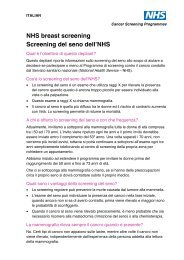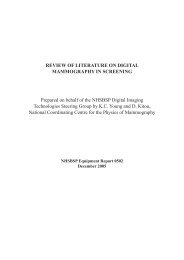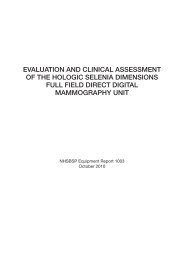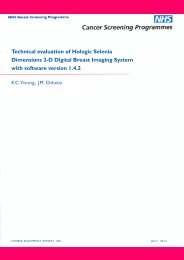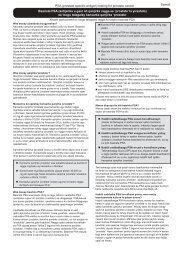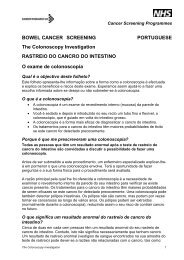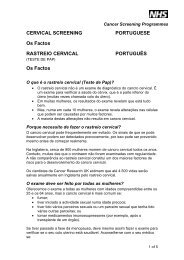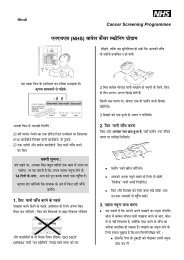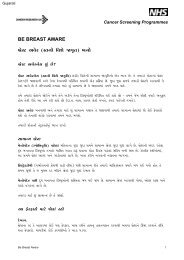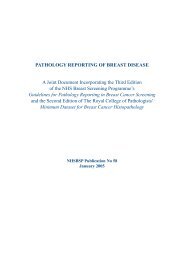reporting lesions in the nhs bowel cancer screening programme
reporting lesions in the nhs bowel cancer screening programme
reporting lesions in the nhs bowel cancer screening programme
Create successful ePaper yourself
Turn your PDF publications into a flip-book with our unique Google optimized e-Paper software.
2 | Report<strong>in</strong>g Lesions <strong>in</strong> <strong>the</strong> NHS Bowel Cancer Screen<strong>in</strong>g Programme<br />
2. DISSECTION OF SUBMITTED LESIONS<br />
The material received will be ei<strong>the</strong>r a biopsy of a lesion, an excision of a polyp or a submucosal<br />
resection of a sessile lesion or a larger resection that is ei<strong>the</strong>r a transendoscopic mucosal excision<br />
(TEM) or a full surgical excision. If only a biopsy is received, <strong>the</strong> size of <strong>the</strong> lesion and completeness<br />
of excision will not be assessable by <strong>the</strong> pathologist and <strong>the</strong>se should be recorded as not<br />
assessable (n/a).<br />
Although <strong>the</strong> pr<strong>in</strong>ciples of pathological <strong>report<strong>in</strong>g</strong> are <strong>the</strong> same as <strong>in</strong> major resections, a number<br />
of features require special attention <strong>in</strong> local excisions of (presumed) early <strong>cancer</strong>s with curative<br />
<strong>in</strong>tent because <strong>the</strong>y are used to determ<strong>in</strong>e <strong>the</strong> necessity for more radical surgery. In addition to<br />
<strong>the</strong> assessment of completeness of excision, <strong>the</strong>se <strong>in</strong>clude record<strong>in</strong>g parameters that predict <strong>the</strong><br />
presence of lymph node metastasis <strong>in</strong> early tumours, namely tumour size, poor differentiation, <strong>the</strong><br />
depth of <strong>in</strong>vasion <strong>in</strong>to <strong>the</strong> submucosa and <strong>the</strong> presence of submucosal lymphovascular <strong>in</strong>vasion. 2–7<br />
However, <strong>the</strong>re is only limited evidence and no consensus <strong>in</strong> <strong>the</strong> published literature on exactly<br />
how some <strong>the</strong>se parameters should be assessed, especially <strong>the</strong> depth of submucosal <strong>in</strong>vasion. We<br />
hope to improve this situation from data derived from <strong>the</strong> <strong>bowel</strong> <strong>cancer</strong> screen<strong>in</strong>g <strong>programme</strong>.<br />
Local excisions are undertaken endoscopically or, <strong>in</strong> <strong>the</strong> case of early rectal tumours, under direct<br />
vision. The majority of carc<strong>in</strong>omas arise with<strong>in</strong> pre-exist<strong>in</strong>g adenomas that may be polypoid, sessile<br />
or flat, and <strong>the</strong> best pathological <strong>in</strong>formation is derived when <strong>lesions</strong> are excised <strong>in</strong> <strong>the</strong>ir entirety<br />
to <strong>in</strong>clude both <strong>the</strong> <strong>in</strong>vasive and pre<strong>in</strong>vasive components. 8 Polypoid <strong>lesions</strong> on a narrow stalk can<br />
be fixed <strong>in</strong>tact, whereas sessile <strong>lesions</strong> should be p<strong>in</strong>ned out, mucosal surface upwards, on a<br />
small piece of cork or o<strong>the</strong>r suitable material, tak<strong>in</strong>g pa<strong>in</strong>s to identify <strong>the</strong> narrow rim of surround<strong>in</strong>g<br />
normal tissue before fix<strong>in</strong>g <strong>in</strong>tact. Piecemeal removal of tumours, which is entirely acceptable for<br />
palliative resections, should be avoided because it precludes a reliable assessment of completeness<br />
of excision.<br />
After fixation, polypoid <strong>lesions</strong> may be bisected through <strong>the</strong> stalk if <strong>the</strong>y measure < 10 mm; larger<br />
polyps are trimmed to leave a central section conta<strong>in</strong><strong>in</strong>g <strong>the</strong> <strong>in</strong>tact stalk, and all fragments are<br />
embedded for histology. It is recommended that at least three sections are taken from blocks<br />
conta<strong>in</strong><strong>in</strong>g <strong>the</strong> stalk. The marg<strong>in</strong>s of larger, sessile <strong>lesions</strong> should be identified with appropriate<br />
coloured markers (<strong>in</strong>ks or gelat<strong>in</strong>e), and <strong>the</strong> whole of <strong>the</strong> specimen transversely sectioned <strong>in</strong>to<br />
3 mm slices and submitted for histology <strong>in</strong> sequentially labelled cassettes. When <strong>the</strong> marg<strong>in</strong> of<br />
normal tissue is less than 3 mm, a 10 mm slice conta<strong>in</strong><strong>in</strong>g <strong>the</strong> relevant marg<strong>in</strong> should be made and<br />
fur<strong>the</strong>r sectioned at right angles.<br />
NHS BCSP September 2007



